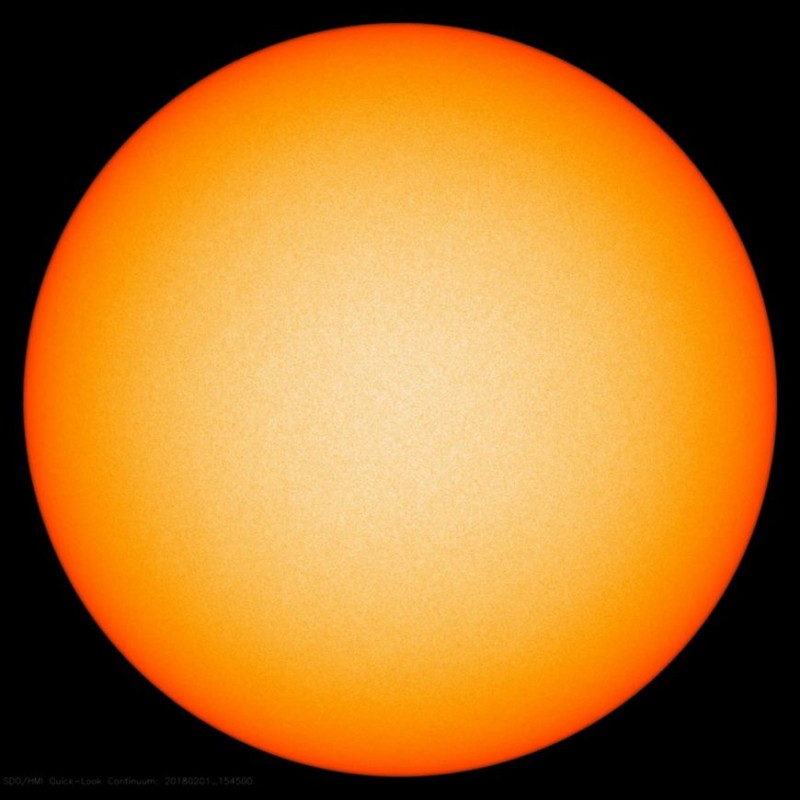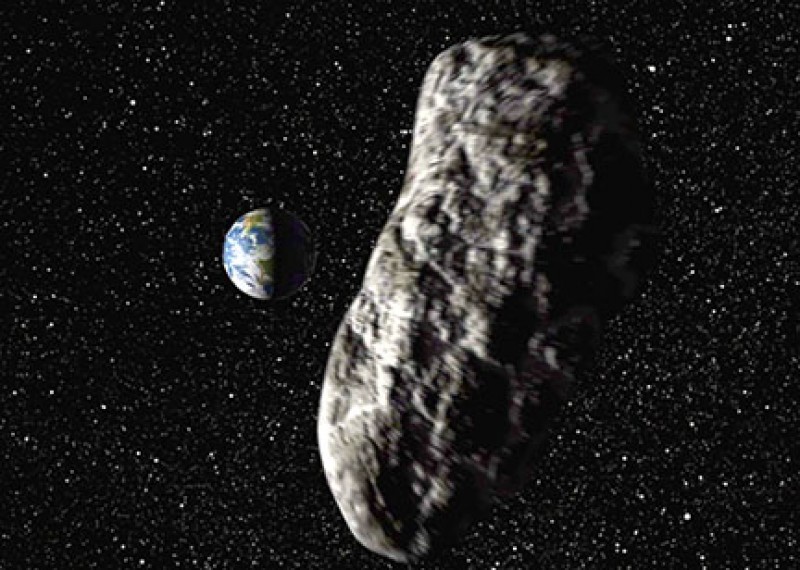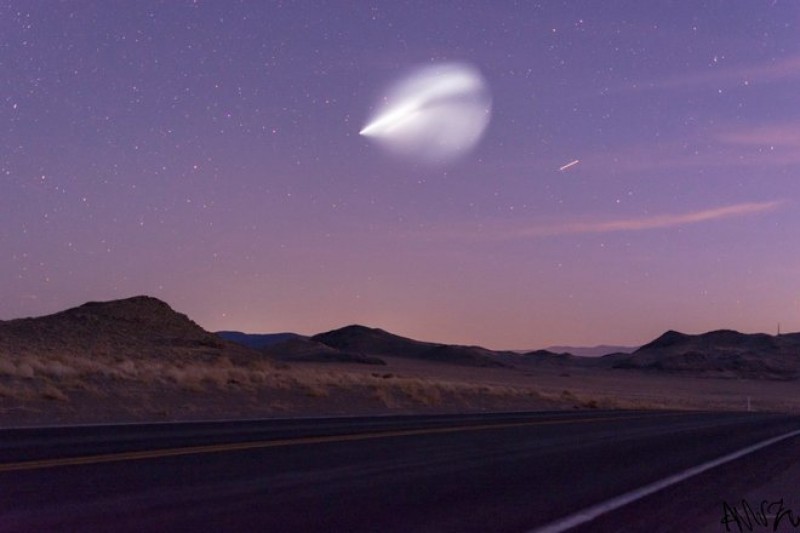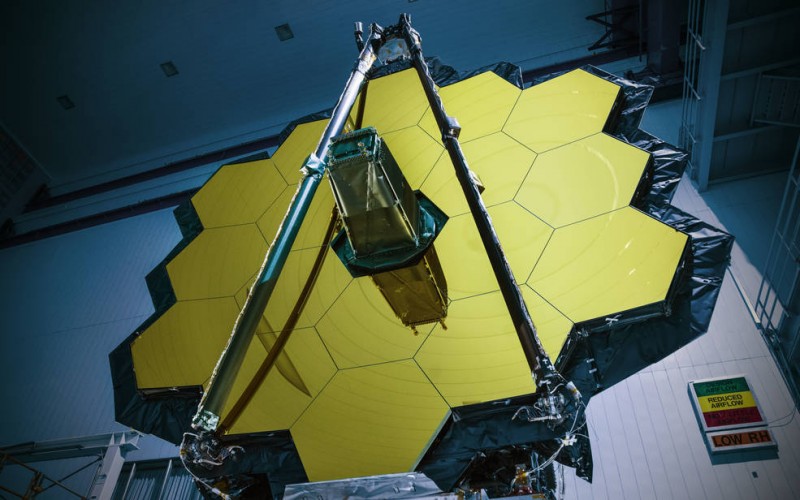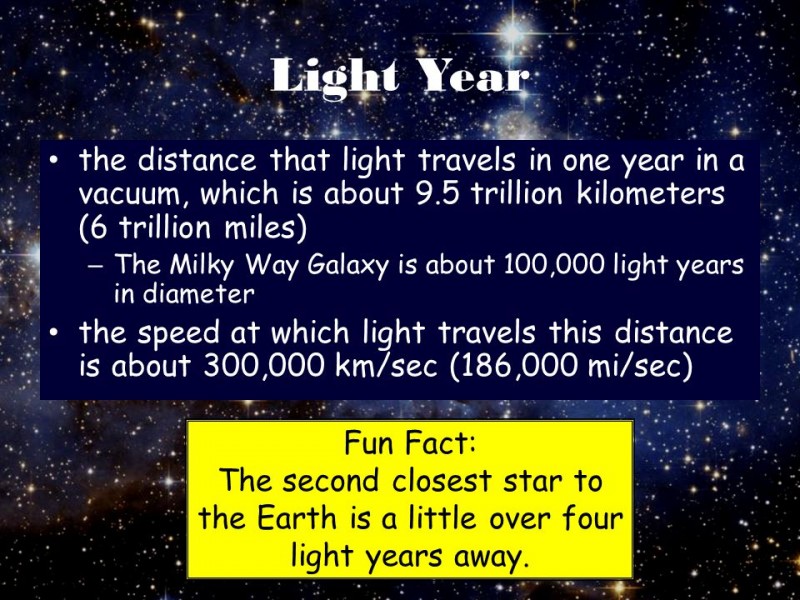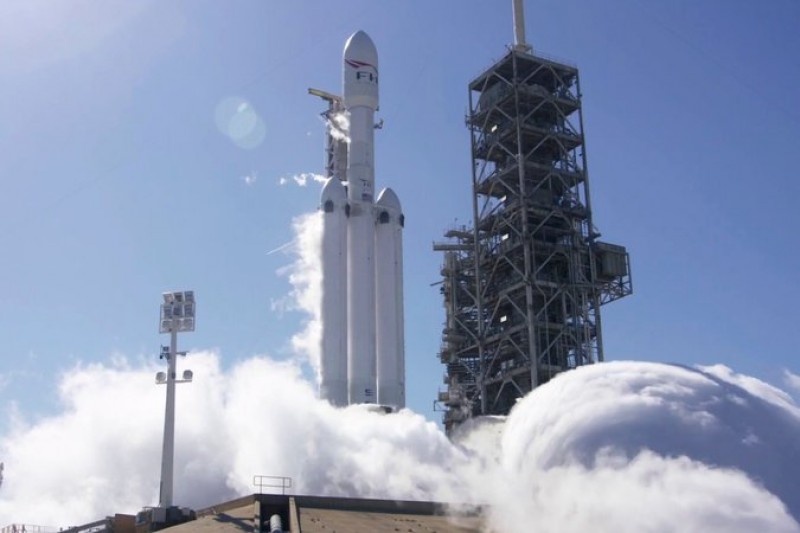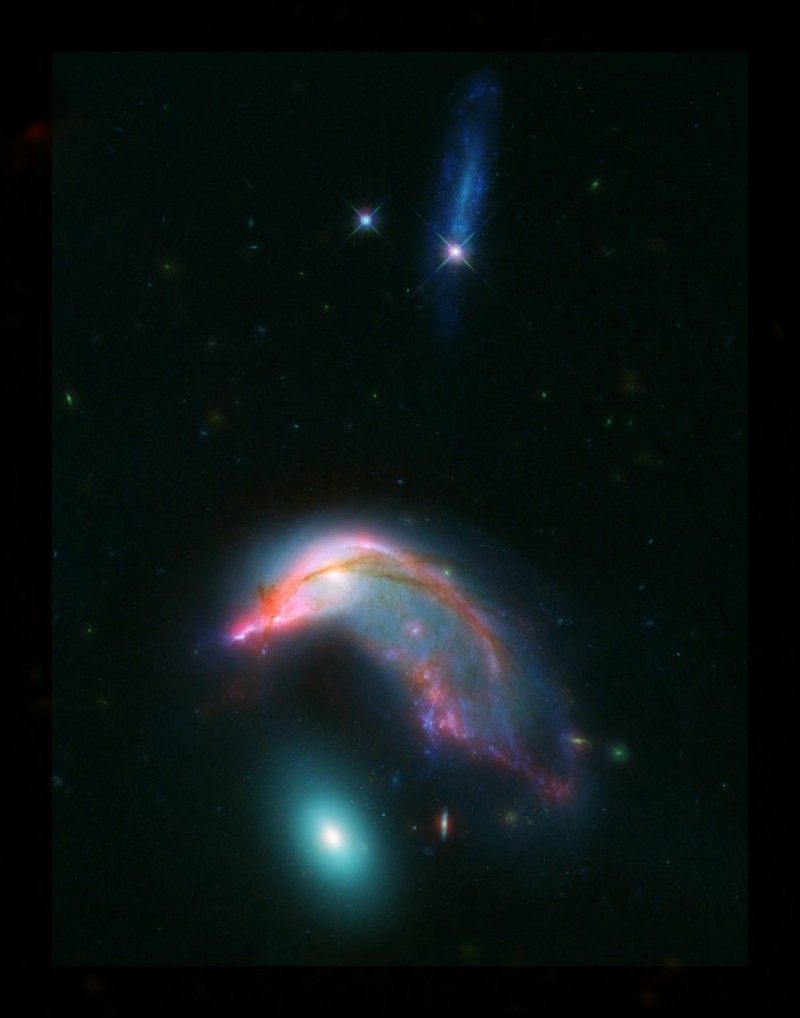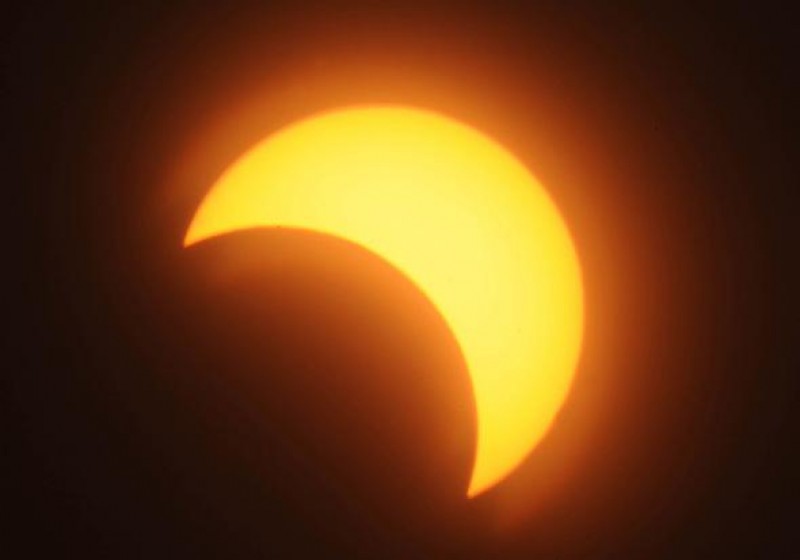Blog
The Naked Sun — Where Have All Its Spots Gone?
Saturday, February 10th 2018 09:38 PM
It lost its spots.
The image is from a video posted by NASA showing the Sun going naked from Jan. 26th to Jan. 30th, when a very small, lonely spot finally turns up. In fact, NASA says that with the exception of this one spot, the Sun was naked for almost two weeks.
Spotless periods like this are common as the Sun approaches the low point in its 11-year solar cycle. We’re headed for that minimum next year.
By contrast, during the peak of a solar cycle, the Sun is freckled with many spots. These crackle with intense magnetic activity producing flashes of x-rays and extreme ultraviolet radiation that can bathe the Earth.
Top: The freckled Sun, with many sunspots during the peak of the solar cycle, is seen to the left. Compare that to the naked Sun with no sunspots on the right. This occurs as activity fades toward solar minimum. Bottom: When sunspot numbers are high during the peak of a solar cycle, the surface cra...
Read More
Read More
Asteroid 2018 CB Zips by Earth
Saturday, February 10th 2018 12:18 AM
Potentially hazardous and near-Earth asteroids zing through Earth's neighborhood nearly every day. Since the weekend, seven small asteroids — including two potentially hazardous ones — came within 0.5 to 16 times the distance of the Moon. The largest, 2002 AJ29, was all of 2,100 feet (640 meters) across. The work week ends with an exceptionally close approach of asteroid 2018 CB, which will skim just 44,000 miles past Earth around 5 p.m. Eastern Time (22:00 UT) Friday, February 9th.
Potentially hazardous asteroids (PHAs) are those at least 328 feet across that approach within 4.6 million miles of Earth. Because asteroid orbits can change over time due to gravitational effects from the Sun and planets, a PHA could potentially impact the planet sometime in the future.
That future looms large and distant because at least for now, no known PHA is predicted to impact Earth for at least a century. There are only probabilities, and those probabilities usually dr...
Read More
Read More
So Long, Starman! Skywatchers Spot Falcon Heavy Leaving Earth's Orbit w/ LIVE FEED
Thursday, February 8th 2018 09:30 PM
Photographer Alexx Mayes captured this view of the Falcon Heavy's third burn near Reno, Nevada on Feb. 6, 2018.
Credit: Alexx Mayes
Riding on the rocket's second stage was Elon Musk's Tesla Roadster, an electric vehicle with a dummy named "Starman" behind the wheel. After the launch, the car and its passenger spent nearly 6 hours orbiting the Earth on the rocket's second stage, or the upper portion of the rocket that is designed to deliver payloads into orbit. [In Photos: SpaceX's 1st Falcon Heavy Rocket Test Launch Success!]
At about 9:45 p.m. EST (0245 GMT), the rocket performed its third and final burn, which was supposed to send this dummy payload cruising by Mars in an elliptical orbit around the sun. (However, the rocket overshot its target and ended up on a path toward the asteroid belt instead.)
Shortly after the second stage initiated this burn, people in the western U.S. began reporting rocket sightings i...
Read More
Read More
NASA's James Webb Space Telescope Arrives in California for Final Assembly (Photos)
Thursday, February 8th 2018 05:59 PM
The two halves of the James Webb Space Telescope (Webb) arrived at Northrop Grumman Aerospace Systems' Space Park facility in Redondo Beach, California, on Feb. 2, after being transported from NASA's Johnson Space Center in Houston, according to a statement from NASA. Later this summer, the optical telescope and integrated science instrument module (OTIS) will be combined with the Telescope's spacecraft element; together they will officially become the Webb observatory.
"This is a major milestone," Eric Smith, director of the James Webb Space Telescope program at NASA, said in the statement. "The Webb observatory, which is the work of thousands of scientists and engineers across the globe, will be carefully tested to ensure it is ready to launch and enable scientists to seek the first luminous objects in the universe and search for signs of habitable planets." [Building the James Webb Space Telescope: Hubble's Successor (Gallery)]
The Space Tele...
Read More
Read More
Kiss the Sky Tonight -- Month of February 2018
Wednesday, February 7th 2018 07:03 PM
NGC 2287, or Messier 41 (M41) is an open cluster in the constellation Canis Major. It contains only about one hundred stars, including several bright red giants (which appear orange, as do all red giants). The bright star in the lower left is a foreground blue giant, not part of the cluster. Roughly 2300 light years away and around 25 light years across, M41 is about 200 million years old. This approximately true-color image was created from eleven images taken in September 1997 using BVR colors at the Burrell Schmidt telescope of Case Western Reserve University's Warner and Swasey Observatory located on Kitt Peak, near Tucson, Arizona. Image Credit: National Optical Astronomy Observatory (NOAO), Association of Universities for Research in Astronomy (AURA), National Science Foundation(NSF).
The winter night sky, filled with brilliant stars, presents one of the best celestial views. Orion, the Great Hunter of Greek mythology, dominates the winter sky. This constellati...
Read More
Read More
Planets in galaxies beyond Milky Way spotted for first time
Wednesday, February 7th 2018 06:58 PM
Using data from NASA’s Chandra X-ray observatory, a team of astrophysicists from the University of Oklahoma identified the extragalactic planets about 3.8 billion light years away. The space observatory helped scientists find about 2,000 objects with comparable mass to the Moon and Jupiter.
Watch the latest video at foxnews.com
A light year, which measures distance in space, equals 6 trillion miles.
SCIENTISTS 'GOOGLED' DATA FROM NASA'S KEPLER SPACE TELESCOPE TO DISCOVER NEW PLANET
The Oklahoma University team used a technique called microlensing, which identifies the gravitational signature of planets orbiting extremely distant stars.
“We are very excited about this discovery. This is the first time anyone has discovered planets outside our galaxy,” said Oklahoma University professor Xinyu Dai in a statement.
“These small planets are the best candidates for the signature...
Read More
Read More
Watch the SpaceX Falcon Heavy Rocket Launch Today
Tuesday, February 6th 2018 09:03 PM
KENNEDY SPACE CENTER, Fla. — After facing early failures and skeptical attitudes, SpaceX has disrupted the business of launching rockets into space by combining cut-rate prices with the routine recovery of used rocket boosters. On Tuesday, the company, founded by Elon Musk, hopes to achieve a new milestone with a successful test launch of its Falcon Heavy rocket, which would be the most powerful rocket in operation in the world today.
Mr. Musk’s ultimate goal — sending people to Mars — requires inventing businesses and profits that do not exist today. He also may be angling for the federal government to help pay his way.
Whatever the case, the Falcon Heavy is SpaceX’s next step in aiming beyond the existing launch business and demonstrating that it can do more than place communications satellites in orbit and haul cargo for NASA to the International Space Station.
What exactly is SpaceX launching?
The Falcon Heavy rocket is essen...
Read More
Read More
Former Astronaut Nominated to Run US Geological Survey
Friday, February 2nd 2018 08:30 PM
WASHINGTON – The White House announced Jan. 26 that it will nominate former NASA astronaut James Reilly to be the next director of the U.S. Geological Survey (USGS).
Reilly, if confirmed, will lead an agency whose responsibilities include the Landsat series of Earth science satellites, but one that is also facing significant budget cuts from the administration.
Reilly joined NASA's astronaut corps in 1994 after working for more than a decade as an oil and gas exploration geologist for Enserch Exploration Inc. He has three degrees in geosciences, including a doctorate, from the University of Texas Dallas.
As an astronaut, Reilly flew on three shuttle missions that visited two space stations. His first flight was on STS-89 in January 1998, docking with the Russian space station Mir. He flew on the STS-104 mission to the International Space Station in July 2001, delivering an airlock module and performing three spacewalks. He returned to the ISS i...
Read More
Read More
Galaxy Duo Looks Just Like a Penguin Guarding Its Egg
Friday, February 2nd 2018 06:52 PM
Fans of the Horsehead and Crab nebulas, take note: There's another giant galactic animal on the scene.
Two interacting galaxies about 23 million light-years from Earth look just like a penguin and its treasured egg in a spectacular new image that combines data from NASA's Hubble and Spitzer space telescopes.
The penguin is NGC 2336, which was probably once a fairly conventional spiral galaxy that looked a lot like our own Milky Way, NASA officials said.
"Rich with newly formed hot stars, seen in visible light from Hubble as bluish filaments, its shape has now been twisted and distorted as it responds to the gravitational tugs of its neighbor," the officials wrote today (Feb. 1) in a description of the newly released photo. "Strands of gas mixed with dust stand out as red filaments detected at longer wavelengths of infrared light seen by Spitzer."
That neighbor is the "egg," a galaxy known as NGC 2937. There's no discernible star formation go...
Read More
Read More
Partial Solar Eclipse and 6 More Can't-Miss Sky Events in February
Thursday, February 1st 2018 09:15 PM
The coming month heralds the return of a cosmic pyramid, a series of stunning lunar pairings, and a partial solar eclipse. You’ll even have the chance to spy on Mars meeting up with its mythical rival.
So, dust off those binoculars and mark your February calendar!
ZODIACAL LIGHT—FEBRUARY 2-16
Starting tomorrow at about an hour after sunset and for the following two weeks, keen sky-watchers in the Northern Hemisphere can hunt down one of the most elusive astronomical phenomena: the zodiacal light.
Best seen from rural areas, this pyramid-shaped light is easily mistaken for the glow from a far-off city just over the horizon, and it is sometimes called the false dawn. But this ethereal light is actually caused by sunlight reflecting off ancient dust suspended between the planets. The best time to catch the ghostly sky light is about an hour after sunset, looking toward the western horizon from a dark region with...
Read More
Read More
